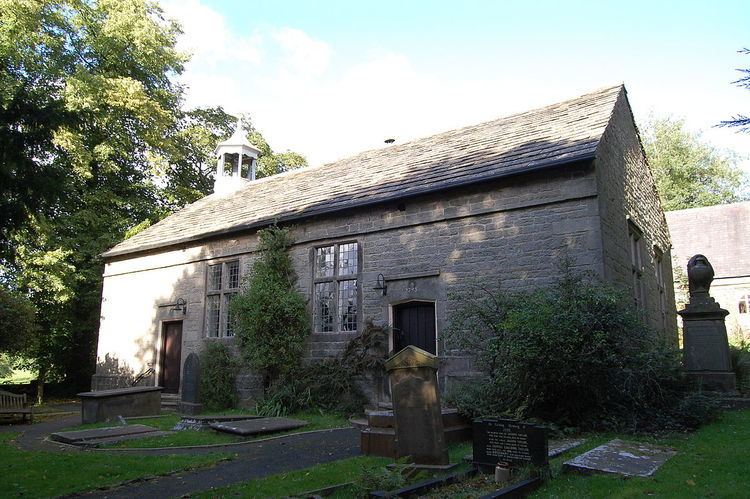Functional status Active | Country England Founded 1703 (1703) Phone +44 1204 520264 | |
 | ||
Similar Rivington Church, Euxton Hall Chapel, Yarrow Bridge, Croston Hall, Buckshaw Hall | ||
Rivington Unitarian Chapel is a place of Unitarian worship in Rivington, Lancashire, England. It was founded in 1703 and is designated as a Grade II* listed building. Its restoration in 1990 was aided by English Heritage. The chapel is an active place of worship: services are held at 2.15pm on the first and third Sunday of each month, and the bell is rung to call worshippers to the service. The congregation is a member of the Manchester District Association of Unitarian and Free Christian Churches, part of the umbrella organisation for British Unitarians, the General Assembly of Unitarian and Free Christian Churches.
Contents
The chapel's motto is:
"Here is quietness for the healing of our spirits;Here is history for the background of our lives;Here let no one be a stranger."History
Nonconformity has its roots in the Clarendon Code, legislation passed after the Commonwealth and the English Restoration, which made it difficult for people who did not conform to the established church. The Act of Uniformity caused about 2,000 clergy to leave the Church of England in the Great Ejection of 1662. The Conventicle Act 1664 prohibited unauthorised religious meetings of more than five people and Nonconformist clergy were not allowed to live near a parish from which they had been banned by the Five Mile Act 1665. There was a strong Puritan element in Rivington, possibly inspired by local martyr George Marsh. The Reverend Samuel Newton was ejected from Rivington Church on "Bartholemew Sunday" in 1662 and most probably the congregation followed him. Newton regained a licence to preach in 1672. The Willoughbys of Parham, of Shaw Place, Heath Charnock were prominent Presbyterians. and Hugh Willoughby was one of the first trustees and benefactors of the chapel, which was built in 1703.
At Rivington Chapel the Unitarian doctrine replaced Presbyterianism in 1754 and around that time the chapel became licensed for weddings. A manse, or minister's house, was built in 1787. A Sunday school began in 1795 in the adjacent school house and a library was added, which operated from 1821.
Four men rallied support to build the Presbyterian Lee Chapel at Horwich; one of them was Moses Cocker, whose farm in Rivington bears his name. The congregation of the chapel stopped an invasion of Methodists who tried to convert them by holding a service at the chapel gates in 1893. J. M. Andrews, the second Prime Minister of Northern Ireland, was married to Jessie Ormrod at the chapel in 1902.
The interior of the chapel had extensive repairs in 1960. The chapel was the focus of a national pilgrimage of Unitarians in 1961. The manse is now a private residence; money from the sale was used to create a garden of remembrance in 1970. After the library closed in 1985 the building became a café, now known as Rivington Village Green Tea Room.
Exterior
The chapel is a plain structure, built of gritstone with quoins at the corners and a slate roof. It has a small, hexagonal bellcote on the west gable. The side walls have two cross-windows with rectangular panes of glass and the gable walls have windows with small diamond-latticed panes of glass. On the south side are two doorways with chamfered surrounds; over one door is a lintel dated 1703. At the north-west corner is a two-storey wing with a tall chimney stack, which was the school house. The building is surrounded by a drystone wall and the chapel's original cast iron gates survive.
Interior
The ceiling is supported by oak beams; the walls are plain and decorated with lime wash. On the north wall between the windows is a raised five-sided panelled pulpit with carved frieze and moulded cornice. The chapel retains its box pews, which were originally individually owned or rented. The Willoughby pew by the south wall has a large ornate canopy with panelled reredos and a moulded and carved cornice in the classical style. There is a choir stall at the east end. The church organ at the south-east corner was a gift in 1843 from Halliwell Road Unitarian Chapel in Bolton, and has been restored. The chapel has electric lighting but the original candle holders have been retained.
Interior
In 1844 workmen discovered a damaged memorial stone to Samuel Newton, the ejected Anglican minister who inspired the building of the chapel. It is fixed on the south wall near the entrance. On the north wall is an 18th-century monument to the Barons Willoughby of Parham. Brass plates on two pew doors are inscribed "Robert Andrews, John William Crompton, Andrew Crompton" and "The Honourable Lord Willoughby".
Graveyard
In the chapelyard are graves and monuments to the Pilkingtons, Andrews, and Cromptons, Lords of the Manor of Rivington; the Shaws, whose ancestry can be traced to 1190; the Ormrods; Samuel Oldknow "of Nottingham, late of Anderton", who died on 7 August 1759 and whose son, Samuel Oldknow, was a factory owner and the first Mayor of Bolton, C. J. Darbyshire. A plaque commemorates Walt Whitman, celebrated on 31 May 1913 by the minister, Samuel Thompson and the Eagle Street College. Four door lintels in the graveyard, two from Rivington Hall and two from farms, have dates between 1695 and 1732.
